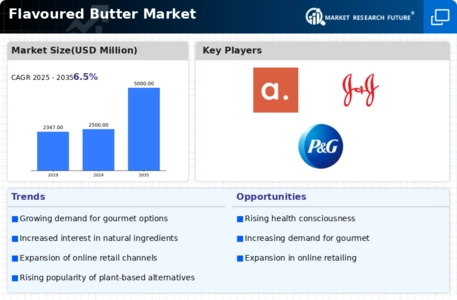-
EXECUTIVE
-
SUMMARY
-
2.
-
MARKET INTRODUCTION
-
2.1.
-
Definition
-
2.2.
-
Scope of the Study
-
2.2.1.
-
Research Objective
-
2.2.2.
-
Assumptions
-
2.2.3.
-
Limitations
-
3.
-
RESEARCH METHODOLOGY
-
3.1.
-
Overview
-
3.2.
-
Data Mining
-
3.3.
-
Secondary Research
-
3.4.
-
Primary Research
-
3.4.1.
-
Primary Interviews and Information Gathering Process
-
Breakdown of Primary Respondents
-
Forecasting Model
-
Market Size Estimation
- Bottom-Up Approach
- Top-Down Approach
-
Data Triangulation
-
Validation
-
MARKET DYNAMICS
-
Overview
-
Drivers
-
Restraints
-
Opportunities
-
MARKET FACTOR ANALYSIS
-
Value Chain Analysis
-
Porter’s Five
- Bargaining Power of Buyers
- Threat of New Entrants
- Threat of Substitutes
- Intensity of Rivalry
-
Forces Analysis
-
5.2.1.
-
Bargaining Power of Suppliers
-
COVID-19 Impact Analysis
- Market Impact Analysis
- Regional Impact
- Opportunity and Threat Analysis
-
GLOBAL FLAVOURED BUTTER
-
MARKET, BY NATURE
-
6.1.
-
Overview
-
6.2.
-
Organic
-
6.3.
-
Conventional
-
7.
-
GLOBAL FLAVOURED BUTTER MARKET, BY PRODUCT TYPE
-
Overview
-
Salted
-
Unsalted
-
GLOBAL FLAVOURED BUTTER MARKET, BY FORMAT
-
Overview
-
Spreadable
-
Non-Spreadable
-
GLOBAL FLAVOURED BUTTER
-
MARKET, BY FORM
-
9.1.
-
Overview
-
9.2.
-
Powder
-
9.3.
-
Liquid
-
9.4.
-
Paste
-
GLOBAL
-
FLAVOURED BUTTER MARKET, BY APPLICATION
-
Overview
-
Milk and Dairy Products
-
Bakery Products
-
Value Added Food and Beverages
-
Dips & Sauces
-
Blends & Seasonings
-
GLOBAL FLAVOURED
-
BUTTER MARKET, BY DISTRIBUTION CHANNEL
-
Overview
-
Store-Based Retailing
-
Online Retailing
-
GLOBAL FLAVOURED BUTTER MARKET, BY REGION
-
Overview
-
North America
- US
- Canada
-
Europe
- Germany
- France
- UK
- Italy
- Spain
- Rest of Europe
-
Asia-Pacific
- China
- India
- Japan
- South Korea
- Australia
- Rest of Asia-Pacific
-
Rest of the World
- Middle East
- Africa
- Latin America
-
COMPETITIVE LANDSCAPE
-
Overview
-
Competitive Analysis
-
Market Share Analysis
-
Major Growth Strategy
-
in the Global Flavoured Butter Market,
-
Competitive Benchmarking
-
Leading Players in Terms of Number of Developments
-
in the Global Flavoured Butter Market,
-
Key developments and Growth Strategies
- New Product Launch/Service
- Joint Ventures
-
Deployment
-
13.7.2.
-
Merger & Acquisitions
-
Major Players Financial Matrix
- Sales & Operating Income, 2022
- Major Players
-
R&D Expenditure. 2022
-
COMPANY PROFILES
-
Nestlé
- Company Overview
- Financial Overview
- Products Offered
- Key Developments
- SWOT Analysis
- Key Strategies
-
The J.M. Smucker Company.
- Company Overview
- Financial Overview
- Products Offered
- Key Developments
- SWOT Analysis
- Key Strategies
-
Unilever
- Company Overview
- Financial Overview
- Products Offered
- Key Developments
- SWOT Analysis
- Key Strategies
-
Butter Buds Inc.
- Company Overview
- Financial Overview
- Products Offered
- Key Developments
- SWOT Analysis
- Key Strategies
-
Mainland
- Company Overview
- Financial Overview
- Products Offered
- Key Developments
- SWOT Analysis
- Key Strategies
-
Arla Foods amba
- Company Overview
- Financial Overview
- Products Offered
- Key Developments
- SWOT Analysis
- Key Strategies
-
Dairy Farmers of
- Company Overview
- Financial Overview
- Products Offered
- Key Developments
- SWOT Analysis
- Key Strategies
-
America, Inc.
-
14.7.1.
-
Company Overview
-
14.7.2.
-
Financial Overview
-
14.7.3.
-
Products Offered
-
14.7.4.
-
Key Developments
-
14.7.5.
-
SWOT Analysis
-
14.7.6.
-
Key Strategies
-
14.8.
-
GCMMF
-
14.8.1.
-
Company Overview
-
14.8.2.
-
Financial Overview
-
14.8.3.
-
Products Offered
-
14.8.4.
-
Key Developments
-
14.8.5.
-
SWOT Analysis
-
14.8.6.
-
Key Strategies
-
14.9.
-
Ornua Co-operative Limited
-
Kerry, DAIRYCHEM
- Company Overview
- Financial Overview
- Products Offered
- Key Developments
- SWOT Analysis
- Key Strategies
-
International Flavors & Fragrances Inc.
- Company Overview
- Financial Overview
- Products Offered
- Key Developments
- SWOT Analysis
- Key Strategies
-
Tatua
- Company Overview
- Financial Overview
- Products Offered
- Key Developments
- SWOT Analysis
- Key Strategies
-
H.B. Taylor Co.
- Company Overview
- Financial Overview
- Products Offered
- Key Developments
- SWOT Analysis
- Key Strategies
-
The Edlong Corporation.
- Company Overview
- Financial Overview
- Products Offered
- Key Developments
- SWOT Analysis
- Key Strategies
-
Abelei Inc.
- Company Overview
- Financial Overview
- Products Offered
- Key Developments
- SWOT Analysis
- Key Strategies
-
Beck Flavors Inc.
- Company Overview
- Financial Overview
- Products Offered
- Key Developments
- SWOT Analysis
- Key Strategies
-
Biospringer
- Company Overview
- Financial Overview
- Products Offered
- Key Developments
- SWOT Analysis
- Key Strategies
-
JENEIL
- Company Overview
- Financial Overview
- Products Offered
- Key Developments
- SWOT Analysis
- Key Strategies
-
Blue Pacific Flavors,
- Company Overview
- Financial Overview
- Products Offered
- Key Developments
- SWOT Analysis
- Key Strategies
-
Inc.
-
14.19.1.
-
Company Overview
-
14.19.2.
-
Financial Overview
-
14.19.3.
-
Products Offered
-
14.19.4.
-
Key Developments
-
14.19.5.
-
SWOT Analysis
-
14.19.6.
-
Key Strategies
-
14.20.
-
Flavor Solutions Inc.
-
14.20.1.
-
Company Overview
-
14.20.2.
-
Financial Overview
-
14.20.3.
-
Products Offered
-
14.20.4.
-
Key Developments
-
14.20.5.
-
SWOT Analysis
-
14.20.6.
-
Key Strategies
-
14.21.
-
Comax MFG Corp. & CORMAN
-
APPENDIX
-
References
-
Related Reports
-
-
LIST OF TABLES
-
GLOBAL FLAVOURED BUTTER MARKET, SYNOPSIS, 2024-2032
-
GLOBAL FLAVOURED
-
BUTTER MARKET, ESTIMATES & FORECAST, 2024-2032 (USD BILLION)
-
GLOBAL FLAVOURED BUTTER
-
MARKET, BY NATURE, 2024-2032 (USD BILLION)
-
GLOBAL FLAVOURED BUTTER MARKET, BY PRODUCT
-
TYPE, 2024-2032 (USD BILLION)
-
GLOBAL FLAVOURED BUTTER MARKET, BY FORMAT, 2024-2032 (USD BILLION)
-
GLOBAL FLAVOURED
-
BUTTER MARKET, BY FORM, 2024-2032 (USD BILLION)
-
GLOBAL FLAVOURED BUTTER MARKET, BY APPLICATION,
-
GLOBAL FLAVOURED BUTTER MARKET, BY DISTRIBUTION CHANNEL, 2024-2032
-
(USD BILLION)
-
TABLE
-
NORTH AMERICA: FLAVOURED BUTTER MARKET, BY NATURE, 2024-2032 (USD BILLION)
-
NORTH AMERICA:
-
FLAVOURED BUTTER MARKET, BY PRODUCT TYPE, 2024-2032 (USD BILLION)
-
NORTH AMERICA: FLAVOURED
-
BUTTER MARKET, BY FORMAT, 2024-2032 (USD BILLION)
-
NORTH AMERICA: FLAVOURED BUTTER MARKET,
-
BY FORM, 2024-2032 (USD BILLION)
-
NORTH AMERICA: FLAVOURED BUTTER MARKET, BY APPLICATION, 2024-2032
-
(USD BILLION)
-
TABLE
-
NORTH AMERICA: FLAVOURED BUTTER MARKET, BY DISTRIBUTION CHANNEL, 2024-2032 (USD
-
BILLION)
-
TABLE
-
US: FLAVOURED BUTTER MARKET, BY NATURE, 2024-2032 (USD BILLION)
-
US: FLAVOURED BUTTER
-
MARKET, BY PRODUCT TYPE, 2024-2032 (USD BILLION)
-
US: FLAVOURED BUTTER MARKET, BY FORMAT,
-
US: FLAVOURED BUTTER MARKET, BY FORM, 2024-2032 (USD BILLION)
-
US: FLAVOURED
-
BUTTER MARKET, BY APPLICATION, 2024-2032 (USD BILLION)
-
US: FLAVOURED BUTTER MARKET, BY DISTRIBUTION
-
CHANNEL, 2024-2032 (USD BILLION)
-
CANADA: FLAVOURED BUTTER MARKET, BY NATURE, 2024-2032 (USD
-
BILLION)
-
TABLE
-
CANADA: FLAVOURED BUTTER MARKET, BY PRODUCT TYPE, 2024-2032 (USD BILLION)
-
CANADA: FLAVOURED
-
BUTTER MARKET, BY FORMAT, 2024-2032 (USD BILLION)
-
CANADA: FLAVOURED BUTTER MARKET, BY FORM,
-
CANADA: FLAVOURED BUTTER MARKET, BY APPLICATION, 2024-2032
-
(USD BILLION)
-
TABLE
-
CANADA: FLAVOURED BUTTER MARKET, BY DISTRIBUTION CHANNEL, 2024-2032 (USD BILLION)
-
EUROPE: FLAVOURED
-
BUTTER MARKET, BY NATURE, 2024-2032 (USD BILLION)
-
EUROPE: FLAVOURED BUTTER MARKET, BY PRODUCT
-
TYPE, 2024-2032 (USD BILLION)
-
EUROPE: FLAVOURED BUTTER MARKET, BY FORMAT, 2024-2032 (USD
-
BILLION)
-
TABLE
-
EUROPE: FLAVOURED BUTTER MARKET, BY FORM, 2024-2032 (USD BILLION)
-
EUROPE: FLAVOURED BUTTER
-
MARKET, BY APPLICATION, 2024-2032 (USD BILLION)
-
EUROPE: FLAVOURED BUTTER MARKET, BY DISTRIBUTION
-
CHANNEL, 2024-2032 (USD BILLION)
-
GERMANY: FLAVOURED BUTTER MARKET, BY NATURE, 2024-2032 (USD
-
BILLION)
-
TABLE
-
GERMANY: FLAVOURED BUTTER MARKET, BY PRODUCT TYPE, 2024-2032 (USD BILLION)
-
GERMANY: FLAVOURED
-
BUTTER MARKET, BY FORMAT, 2024-2032 (USD BILLION)
-
GERMANY: FLAVOURED BUTTER MARKET, BY FORM,
-
GERMANY: FLAVOURED BUTTER MARKET, BY APPLICATION, 2024-2032
-
(USD BILLION)
-
TABLE
-
GERMANY: FLAVOURED BUTTER MARKET, BY DISTRIBUTION CHANNEL, 2024-2032 (USD BILLION)
-
FRANCE: FLAVOURED
-
BUTTER MARKET, BY NATURE, 2024-2032 (USD BILLION)
-
FRANCE: FLAVOURED BUTTER MARKET, BY PRODUCT
-
TYPE, 2024-2032 (USD BILLION)
-
FRANCE: FLAVOURED BUTTER MARKET, BY FORMAT, 2024-2032 (USD
-
BILLION)
-
TABLE
-
FRANCE: FLAVOURED BUTTER MARKET, BY FORM, 2024-2032 (USD BILLION)
-
FRANCE: FLAVOURED BUTTER
-
MARKET, BY APPLICATION, 2024-2032 (USD BILLION)
-
FRANCE: FLAVOURED BUTTER MARKET, BY DISTRIBUTION
-
CHANNEL, 2024-2032 (USD BILLION)
-
ITALY: FLAVOURED BUTTER MARKET, BY NATURE, 2024-2032 (USD
-
BILLION)
-
TABLE
-
ITALY: FLAVOURED BUTTER MARKET, BY PRODUCT TYPE, 2024-2032 (USD BILLION)
-
ITALY: FLAVOURED
-
BUTTER MARKET, BY FORMAT, 2024-2032 (USD BILLION)
-
ITALY: FLAVOURED BUTTER MARKET, BY FORM,
-
ITALY: FLAVOURED BUTTER MARKET, BY APPLICATION, 2024-2032
-
(USD BILLION)
-
TABLE
-
ITALY: FLAVOURED BUTTER MARKET, BY DISTRIBUTION CHANNEL, 2024-2032 (USD BILLION)
-
SPAIN: FLAVOURED
-
BUTTER MARKET, BY NATURE, 2024-2032 (USD BILLION)
-
SPAIN: FLAVOURED BUTTER MARKET, BY PRODUCT
-
TYPE, 2024-2032 (USD BILLION)
-
SPAIN: FLAVOURED BUTTER MARKET, BY FORMAT, 2024-2032 (USD
-
BILLION)
-
TABLE
-
SPAIN: FLAVOURED BUTTER MARKET, BY FORM, 2024-2032 (USD BILLION)
-
SPAIN: FLAVOURED BUTTER
-
MARKET, BY APPLICATION, 2024-2032 (USD BILLION)
-
SPAIN: FLAVOURED BUTTER MARKET, BY DISTRIBUTION
-
CHANNEL, 2024-2032 (USD BILLION)
-
UK: FLAVOURED BUTTER MARKET, BY NATURE, 2024-2032 (USD BILLION)
-
UK: FLAVOURED
-
BUTTER MARKET, BY PRODUCT TYPE, 2024-2032 (USD BILLION)
-
UK: FLAVOURED BUTTER MARKET, BY FORMAT,
-
UK: FLAVOURED BUTTER MARKET, BY FORM, 2024-2032 (USD BILLION)
-
UK: FLAVOURED
-
BUTTER MARKET, BY APPLICATION, 2024-2032 (USD BILLION)
-
UK: FLAVOURED BUTTER MARKET, BY DISTRIBUTION
-
CHANNEL, 2024-2032 (USD BILLION)
-
REST OF EUROPE: FLAVOURED BUTTER MARKET, BY NATURE, 2024-2032
-
(USD BILLION)
-
TABLE
-
REST OF EUROPE: FLAVOURED BUTTER MARKET, BY PRODUCT TYPE, 2024-2032 (USD BILLION)
-
REST OF EUROPE:
-
FLAVOURED BUTTER MARKET, BY FORMAT, 2024-2032 (USD BILLION)
-
REST OF EUROPE: FLAVOURED BUTTER MARKET,
-
BY FORM, 2024-2032 (USD BILLION)
-
REST OF EUROPE: FLAVOURED BUTTER MARKET, BY APPLICATION, 2024-2032
-
(USD BILLION)
-
TABLE
-
REST OF EUROPE: FLAVOURED BUTTER MARKET, BY DISTRIBUTION CHANNEL, 2024-2032 (USD
-
BILLION)
-
TABLE
-
ASIA-PACIFIC: FLAVOURED BUTTER MARKET, BY NATURE, 2024-2032 (USD BILLION)
-
ASIA-PACIFIC:
-
FLAVOURED BUTTER MARKET, BY PRODUCT TYPE, 2024-2032 (USD BILLION)
-
ASIA-PACIFIC: FLAVOURED
-
BUTTER MARKET, BY FORMAT, 2024-2032 (USD BILLION)
-
ASIA-PACIFIC: FLAVOURED BUTTER MARKET, BY
-
FORM, 2024-2032 (USD BILLION)
-
ASIA-PACIFIC: FLAVOURED BUTTER MARKET, BY APPLICATION, 2024-2032
-
(USD BILLION)
-
TABLE
-
ASIA-PACIFIC: FLAVOURED BUTTER MARKET, BY DISTRIBUTION CHANNEL, 2024-2032 (USD
-
BILLION)
-
TABLE
-
JAPAN: FLAVOURED BUTTER MARKET, BY NATURE, 2024-2032 (USD BILLION)
-
JAPAN: FLAVOURED
-
BUTTER MARKET, BY PRODUCT TYPE, 2024-2032 (USD BILLION)
-
JAPAN: FLAVOURED BUTTER MARKET, BY FORMAT,
-
JAPAN: FLAVOURED BUTTER MARKET, BY FORM, 2024-2032 (USD BILLION)
-
JAPAN: FLAVOURED
-
BUTTER MARKET, BY APPLICATION, 2024-2032 (USD BILLION)
-
JAPAN: FLAVOURED BUTTER MARKET, BY DISTRIBUTION
-
CHANNEL, 2024-2032 (USD BILLION)
-
CHINA: FLAVOURED BUTTER MARKET, BY NATURE, 2024-2032 (USD
-
BILLION)
-
TABLE
-
CHINA: FLAVOURED BUTTER MARKET, BY PRODUCT TYPE, 2024-2032 (USD BILLION)
-
CHINA: FLAVOURED
-
BUTTER MARKET, BY FORMAT, 2024-2032 (USD BILLION)
-
CHINA: FLAVOURED BUTTER MARKET, BY FORM,
-
CHINA: FLAVOURED BUTTER MARKET, BY APPLICATION, 2024-2032
-
(USD BILLION)
-
TABLE
-
CHINA: FLAVOURED BUTTER MARKET, BY DISTRIBUTION CHANNEL, 2024-2032 (USD BILLION)
-
INDIA: FLAVOURED
-
BUTTER MARKET, BY NATURE, 2024-2032 (USD BILLION)
-
INDIA: FLAVOURED BUTTER MARKET, BY PRODUCT
-
TYPE, 2024-2032 (USD BILLION)
-
INDIA: FLAVOURED BUTTER MARKET, BY FORMAT, 2024-2032 (USD
-
BILLION)
-
TABLE
-
INDIA: FLAVOURED BUTTER MARKET, BY FORM, 2024-2032 (USD BILLION)
-
INDIA: FLAVOURED BUTTER
-
MARKET, BY APPLICATION, 2024-2032 (USD BILLION)
-
INDIA: FLAVOURED BUTTER MARKET, BY DISTRIBUTION
-
CHANNEL, 2024-2032 (USD BILLION)
-
AUSTRALIA: FLAVOURED BUTTER MARKET, BY NATURE, 2024-2032 (USD
-
BILLION)
-
TABLE
-
AUSTRALIA: FLAVOURED BUTTER MARKET, BY PRODUCT TYPE, 2024-2032 (USD BILLION)
-
AUSTRALIA: FLAVOURED
-
BUTTER MARKET, BY FORMAT, 2024-2032 (USD BILLION)
-
AUSTRALIA: FLAVOURED BUTTER MARKET, BY FORM,
-
AUSTRALIA: FLAVOURED BUTTER MARKET, BY APPLICATION, 2024-2032
-
(USD BILLION)
-
TABLE
-
AUSTRALIA: FLAVOURED BUTTER MARKET, BY DISTRIBUTION CHANNEL, 2024-2032 (USD BILLION)
-
SOUTH KOREA:
-
FLAVOURED BUTTER MARKET, BY NATURE, 2024-2032 (USD BILLION)
-
SOUTH KOREA: FLAVOURED BUTTER MARKET, BY
-
PRODUCT TYPE, 2024-2032 (USD BILLION)
-
SOUTH KOREA: FLAVOURED BUTTER MARKET, BY FORMAT,
-
SOUTH KOREA: FLAVOURED BUTTER MARKET, BY FORM, 2024-2032 (USD
-
BILLION)
-
TABLE
-
SOUTH KOREA: FLAVOURED BUTTER MARKET, BY APPLICATION, 2024-2032 (USD BILLION)
-
SOUTH KOREA:
-
FLAVOURED BUTTER MARKET, BY DISTRIBUTION CHANNEL, 2024-2032 (USD BILLION)
-
REST OF ASIA-PACIFIC:
-
FLAVOURED BUTTER MARKET, BY NATURE, 2024-2032 (USD BILLION)
-
REST OF ASIA-PACIFIC: FLAVOURED BUTTER MARKET,
-
BY PRODUCT TYPE, 2024-2032 (USD BILLION)
-
REST OF ASIA-PACIFIC: FLAVOURED BUTTER MARKET,
-
BY FORMAT, 2024-2032 (USD BILLION)
-
REST OF ASIA-PACIFIC: FLAVOURED BUTTER MARKET,
-
BY FORM, 2024-2032 (USD BILLION)
-
REST OF ASIA-PACIFIC: FLAVOURED BUTTER MARKET, BY APPLICATION,
-
REST OF ASIA-PACIFIC: FLAVOURED BUTTER MARKET, BY DISTRIBUTION
-
CHANNEL, 2024-2032 (USD BILLION)
-
REST OF THE WORLD: FLAVOURED BUTTER MARKET, BY NATURE, 2024-2032
-
(USD BILLION)
-
TABLE
-
REST OF THE WORLD: FLAVOURED BUTTER MARKET, BY PRODUCT TYPE, 2024-2032 (USD BILLION)
-
REST OF THE
-
WORLD: FLAVOURED BUTTER MARKET, BY FORMAT, 2024-2032 (USD BILLION)
-
REST OF THE WORLD: FLAVOURED
-
BUTTER MARKET, BY FORM, 2024-2032 (USD BILLION)
-
REST OF THE WORLD: FLAVOURED BUTTER MARKET,
-
BY APPLICATION, 2024-2032 (USD BILLION)
-
REST OF THE WORLD: FLAVOURED BUTTER MARKET, BY
-
DISTRIBUTION CHANNEL, 2024-2032 (USD BILLION)
-
MIDDLE EAST: FLAVOURED BUTTER MARKET, BY
-
NATURE, 2024-2032 (USD BILLION)
-
MIDDLE EAST: FLAVOURED BUTTER MARKET, BY PRODUCT TYPE, 2024-2032
-
(USD BILLION)
-
TABLE
-
MIDDLE EAST: FLAVOURED BUTTER MARKET, BY FORMAT, 2024-2032 (USD BILLION)
-
MIDDLE EAST:
-
FLAVOURED BUTTER MARKET, BY FORM, 2024-2032 (USD BILLION)
-
MIDDLE EAST: FLAVOURED BUTTER MARKET, BY
-
APPLICATION, 2024-2032 (USD BILLION)
-
MIDDLE EAST: FLAVOURED BUTTER MARKET, BY DISTRIBUTION
-
CHANNEL, 2024-2032 (USD BILLION)
-
AFRICA: FLAVOURED BUTTER MARKET, BY NATURE, 2024-2032 (USD
-
BILLION)
-
TABLE
-
AFRICA: FLAVOURED BUTTER MARKET, BY PRODUCT TYPE, 2024-2032 (USD BILLION)
-
AFRICA: FLAVOURED
-
BUTTER MARKET, BY FORMAT, 2024-2032 (USD BILLION)
-
AFRICA: FLAVOURED BUTTER MARKET, BY FORM,
-
AFRICA: FLAVOURED BUTTER MARKET, BY APPLICATION, 2024-2032
-
(USD BILLION)
-
TABLE
-
AFRICA: FLAVOURED BUTTER MARKET, BY DISTRIBUTION CHANNEL, 2024-2032 (USD BILLION)
-
LATIN AMERICA:
-
FLAVOURED BUTTER MARKET, BY NATURE, 2024-2032 (USD BILLION)
-
LATIN AMERICA: FLAVOURED BUTTER MARKET,
-
BY PRODUCT TYPE, 2024-2032 (USD BILLION)
-
LATIN AMERICA: FLAVOURED BUTTER MARKET, BY FORMAT,
-
LATIN AMERICA: FLAVOURED BUTTER MARKET, BY FORM, 2024-2032
-
(USD BILLION)
-
TABLE
-
LATIN AMERICA: FLAVOURED BUTTER MARKET, BY APPLICATION, 2024-2032 (USD BILLION)
-
LATIN AMERICA:
-
FLAVOURED BUTTER MARKET, BY DISTRIBUTION CHANNEL, 2024-2032 (USD BILLION)
-
LIST OF FIGURES
-
RESEARCH PROCESS
-
MARKET STRUCTURE
-
FOR THE GLOBAL FLAVOURED BUTTER MARKET
-
MARKET DYNAMICS FOR THE GLOBAL FLAVOURED BUTTER
-
MARKET
-
FIGURE
-
GLOBAL FLAVOURED BUTTER MARKET, SHARE (%), BY NATURE, 2022
-
GLOBAL FLAVOURED BUTTER MARKET, SHARE (%),
-
BY PRODUCT TYPE, 2022
-
FIGURE
-
GLOBAL FLAVOURED BUTTER MARKET, SHARE (%), BY FORMAT, 2022
-
GLOBAL FLAVOURED BUTTER MARKET, SHARE (%),
-
BY FORM, 2022
-
FIGURE
-
GLOBAL FLAVOURED BUTTER MARKET, SHARE (%), BY APPLICATION, 2022
-
GLOBAL FLAVOURED BUTTER
-
MARKET, SHARE (%), BY DISTRIBUTION CHANNEL, 2022
-
GLOBAL FLAVOURED BUTTER MARKET, SHARE (%),
-
BY REGION, 2022
-
FIGURE
-
NORTH AMERICA: FLAVOURED BUTTER MARKET, SHARE (%), BY REGION, 2022
-
EUROPE: FLAVOURED
-
BUTTER MARKET, SHARE (%), BY REGION, 2022
-
ASIA-PACIFIC: FLAVOURED BUTTER MARKET,
-
SHARE (%), BY REGION, 2022
-
REST OF THE WORLD: FLAVOURED BUTTER MARKET, SHARE (%), BY
-
REGION, 2022
-
FIGURE
-
GLOBAL FLAVOURED BUTTER MARKET: COMPANY SHARE ANALYSIS, 2022 (%)
-
ABELEI INC.: FINANCIAL
-
OVERVIEW SNAPSHOT
-
FIGURE
-
ABELEI INC.: SWOT ANALYSIS
-
ARLA FOODS AMBA: FINANCIAL OVERVIEW SNAPSHOT
-
ARLA FOODS AMBA: SWOT
-
ANALYSIS
-
FIGURE
-
BECK FLAVORS INC.: FINANCIAL OVERVIEW SNAPSHOT
-
BECK FLAVORS INC.: SWOT ANALYSIS
-
BIOSPRINGER:
-
FINANCIAL OVERVIEW SNAPSHOT
-
BIOSPRINGER: SWOT ANALYSIS
-
BLUE PACIFIC FLAVORS, INC.: FINANCIAL OVERVIEW
-
SNAPSHOT
-
FIGURE
-
BLUE PACIFIC FLAVORS, INC.: SWOT ANALYSIS
-
BUTTER BUDS INC.: FINANCIAL OVERVIEW SNAPSHOT
-
BUTTER BUDS
-
INC.: SWOT ANALYSIS
-
FIGURE
-
COMAX MFG CORP. & CORMAN: FINANCIAL OVERVIEW SNAPSHOT
-
COMAX MFG CORP. & CORMAN: SWOT ANALYSIS
-
DAIRY FARMERS
-
OF AMERICA, INC.: FINANCIAL OVERVIEW SNAPSHOT
-
DAIRY FARMERS OF AMERICA, INC.: SWOT ANALYSIS
-
FLAVOR SOLUTIONS
-
INC.: FINANCIAL OVERVIEW SNAPSHOT
-
FLAVOR SOLUTIONS INC.: SWOT ANALYSIS
-
GCMMF: FINANCIAL OVERVIEW SNAPSHOT
-
GCMMF: SWOT
-
ANALYSIS
-
FIGURE
-
H.B. TAYLOR CO.: FINANCIAL OVERVIEW SNAPSHOT
-
H.B. TAYLOR CO.: SWOT ANALYSIS
-
INTERNATIONAL
-
FLAVORS & FRAGRANCES INC.: FINANCIAL OVERVIEW SNAPSHOT
-
INTERNATIONAL FLAVORS & FRAGRANCES
-
INC.: SWOT ANALYSIS
-
FIGURE
-
JENEIL: FINANCIAL OVERVIEW SNAPSHOT
-
JENEIL: SWOT ANALYSIS
-
KERRY, DAIRYCHEM: FINANCIAL OVERVIEW SNAPSHOT
-
KERRY, DAIRYCHEM:
-
SWOT ANALYSIS
-
FIGURE
-
MAINLAND: FINANCIAL OVERVIEW SNAPSHOT
-
MAINLAND: SWOT ANALYSIS
-
NESTLE: FINANCIAL OVERVIEW SNAPSHOT
-
NESTLE: SWOT
-
ANALYSIS
-
FIGURE
-
ORNUA CO-OPERATIVE LIMITED: FINANCIAL OVERVIEW SNAPSHOT
-
ORNUA CO-OPERATIVE LIMITED: SWOT ANALYSIS
-
TATUA: FINANCIAL
-
OVERVIEW SNAPSHOT
-
FIGURE
-
TATUA: SWOT ANALYSIS
-
THE EDLONG CORPORATION.: FINANCIAL OVERVIEW SNAPSHOT
-
THE EDLONG
-
CORPORATION.: SWOT ANALYSIS
-
THE J.M. SMUCKER COMPANY.: FINANCIAL OVERVIEW SNAPSHOT
-
THE J.M. SMUCKER
-
COMPANY.: SWOT ANALYSIS
-
UNILEVER: FINANCIAL OVERVIEW SNAPSHOT
-
UNILEVER: SWOT ANALYSIS








Leave a Comment